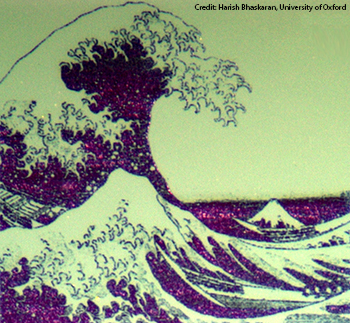
“The Great Wave off Kanagawa,” drawn with the nanopixel technology.
Researchers from the University of Oxford and the University of Exeter, U.K., reveal a new high-resolution imaging technology that could provide nanopixel-level resolution in thin, flexible, low-energy film displays (Nature, doi:10.1038/nature13487). Potential applications for the films include “smart” glasses, artificial retinas and foldable/bendable screens.
The team was originally studying the electrical and optical properties of a phase change material—Ge2Sb2Te5 (GST)—when they came up with the idea of using GST for a new type of display. They sandwiched very thin layers of GST between transparent electrode layers made of indium tin oxide to make seven-layer stacks measuring 300 nm X 300 nm. The stacks function as pixel-like devices that can be switched on and off with a small electrical current. When “on,” the stack emits a colored dot (the size of the bottom electrode layer determines color). When combined, the stacks act as a canvas for images with nano-scale resolution.
Unlike LCD screens that need to be continuously refreshed, the nanopixels remain on or off until you want to change the image. This greatly reduces the amount of energy needed to power the film display.
The researchers have filed a patent on their discovery and are discussing the technology with companies and potential investors.
